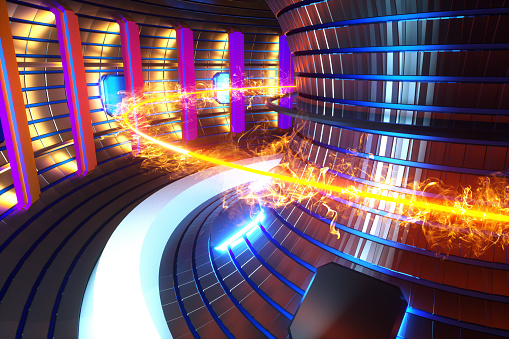
Editor's note: Djoomart Otorbaev is the former prime minister of the Kyrgyz Republic, a distinguished professor of the Belt and Road School of Beijing Normal University and a member of the Nizami Ganjavi International Center. The article reflects the author's views and not necessarily those of CGTN.
On December 28, 1981, at a meeting of the P.N. Lebedev Physical Institute of the USSR Academy of Sciences, I defended my PhD thesis in the field of plasma physics. The primary reviewer of my work was Professor Oleg Krokhin, who was widely known to the scientific world because he and Nobel Prize laureate Nikolai Basov were the first to propose laser thermonuclear fusion in 1961. The ability of lasers to concentrate enormous energy in tiny volumes for ultrashort periods was at the heart of this idea.
Although I have not worked in the field of plasma physics for a long time, I was delighted to learn that on August 17, physicists had achieved a significant result in laser fusion research. At the enormous National Ignition Facility of the Lawrence Livermore National Laboratory in the U.S., having the size of three football fields, 192 super-powerful laser beams recreate temperature and pressure like those found in the cores of stars or inside exploding nuclear weapons. They focus a laser beam on a target creating a miniature human hair-sized "hot plasma" beam that generates more than 10 quadrillion watts of thermonuclear energy in 100 trillionths of a second.
In an experiment, a laser shot launched a controlled thermonuclear explosion. It produced eight times more energy than ever achieved - 1.35 megajoules (MJ) of power, roughly equal to the kinetic energy of a car traveling at 160 kilometers per hour, which was about 70 percent of the laser energy delivered to the target. Achieving ignition means obtaining a melting power of more than 1.9 MJ imposed by the laser. The laser pulse compressed the plasma to 100 times the density of lead and heated it to 100 million degrees Celsius, which is hotter than at the center of the sun. These conditions help trigger thermonuclear fusion.
Physicists know that controlled thermonuclear fusion will provide humanity with unlimited environmentally friendly energy, supporting the synthesis of nuclei of light elements into heavier ones. Similar reactions occur in the interior of stars.
"The pace of improvement in energy output has been rapid, suggesting we may soon reach more energy milestones, such as exceeding the energy input from the lasers used to kick-start the process," said Professor Jeremy Chittenden, co-director of the Center for Inertial Fusion Studies at Imperial College London.

Physicists at the Lawrence Livermore National Laboratory believe that they have now achieved "burning plasma," where fusion reactions of hydrogen atoms can release energy sufficient for further self-sustaining fusion. Thus, scientists get closer to the unlimited source of energy – a remarkable achievement!
To reach a controlled thermonuclear reaction, scientists use methods other than laser heating. Many experts believe that the so-called tokamak technology is currently the most promising for creating controlled thermonuclear fusion. Soviet physicists Igor Tamm and Andrei Sakharov first proposed such an idea in the 1950s. This concept is known as magnetic confinement fusion (MCF), where the specialized donut-shaped reactors called tokamaks apply magnetic fields to contain and compress hydrogen fuel.
These days experts from more than 50 countries are involved in research in developing nuclear fusion technologies. Among the leaders of scientific programs are European countries, the U.S., China and Russia. Work has intensified recently in the face of rapidly growing energy demand and accelerated climate change from burning fossil fuels.
Currently, the International Thermonuclear Experimental Reactor (ITER) is the biggest international mega-project in thermonuclear fusion research, where several nations are collaborating to build the world's largest tokamak in Cadarache, southern France. The developers plan to start the operations at the facility in 2025. The ITER will be the largest of more than 100 fusion reactors constructed since the 1950s, with a plasma volume 10 times that of any other tokamak in operation today.
Thousands of engineers and scientists have contributed to the design of ITER since the idea for an international joint experiment in fusion was first launched in 1985. The ITER Members - China, the European Union, India, Japan, South Korea, Russia, and the U.S. are now engaged in a 35-year collaboration to build and operate the ITER experimental device and bring fusion to the point where the partners will have the actual demonstration fusion reactor.
Converting the concept into an unlimited energy source will be a long process. It will require overcoming severe technical problems, such as recreating this experiment several times per second to obtain a permanent energy source.
The latest news undoubtedly represents significant progress in understanding the fundamental properties of high-temperature plasma. But we shouldn't delude ourselves yet. This exciting news does not indicate when and how scientists will receive the long-awaited unlimited energy source. Indeed, recent experiments have generated a significant amount of energy, but only for a short time. Scientists are confident that such experiments will generate even more power over more extended periods as yields increase. Humanity is on a straight path to the commercial production of unlimited amounts of electricity. The energy of the future will become unlimited and green.
(If you want to contribute and have specific expertise, please contact us at opinions@cgtn.com.)

